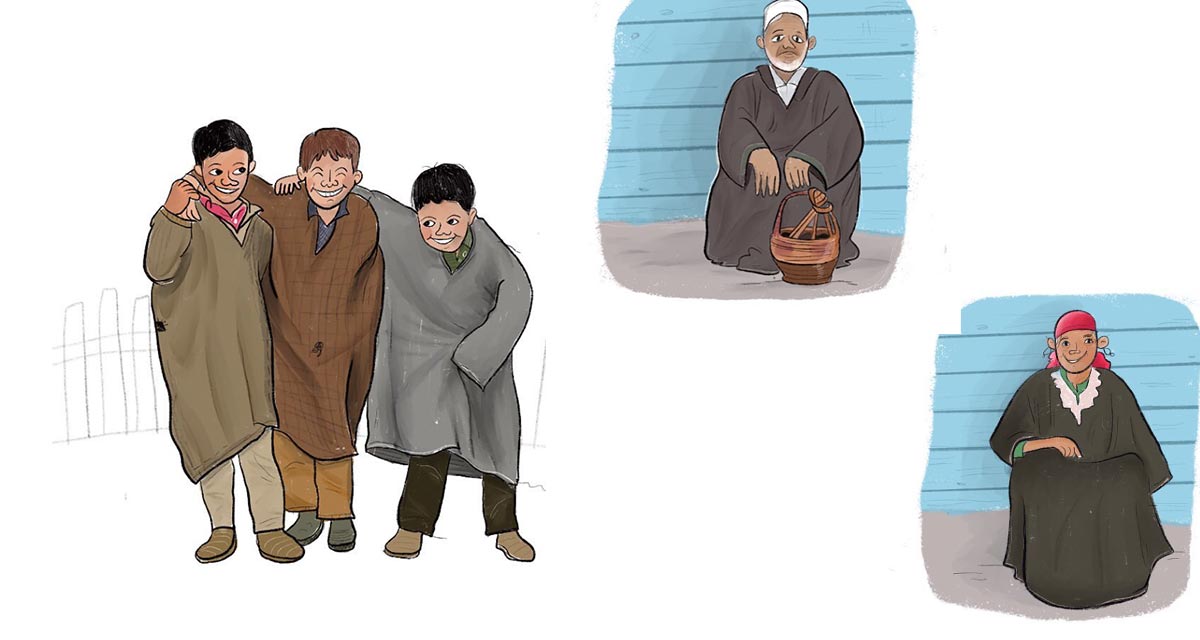
The traditional attire of Kashmir reflects the unique blend of cultural influences from the various dynasties and empires that have governed the region. Kashmiri dresses are celebrated for their intricate embroidery, luxurious fabrics, and warmth, crafted to adapt to the cold climate. Below is an overview of the key traditional garments for both men and women in Kashmir, along with their cultural significance.
1. Pheran
The Pheran is perhaps the most iconic piece of Kashmiri attire, worn by both men and women. It is a long, loose-fitting garment reaching below the knees, made from wool or cotton to provide insulation against the cold. Historically, the Pheran was designed to accommodate the wearing of a Kangri (an earthen pot filled with burning embers) underneath it to keep the wearer warm during the harsh winters.
- Women’s Pheran: Women’s Pherans are often more elaborate, featuring intricate tilla (gold or silver) embroidery along the necklines, cuffs, and hems. They are usually made from fine wool or pashmina and sometimes decorated with floral or paisley designs.
- Men’s Pheran: Men’s Pherans are typically simpler and made from heavier woolen material for better insulation. They are generally darker in color and have less elaborate embroidery, reflecting a more utilitarian design.
2. Goncha
Goncha is a traditional dress primarily worn by Kashmiri men. It resembles a long robe and is often made from woolen material to provide warmth. The Goncha is tied at the waist with a Lacha, a type of waist belt, and is typically worn with a loose-fitting trouser called Suthan. This attire is especially popular in the region of Ladakh but has roots in the broader Kashmiri culture.
3. Poots and Choga
In addition to the Pheran and Goncha, Kashmiris also wear Poots and Choga, which are traditional robes designed to combat the cold climate. Choga is a long, flowing gown-like garment, sometimes layered over other clothing for additional warmth. These garments are particularly prevalent among the elder members of Kashmiri society and are typically associated with the affluent due to their luxurious appearance and craftsmanship.
4. Tarbands and Kasaba
Tarband refers to the traditional headgear worn by Kashmiri men. It is a type of turban that serves both practical and cultural purposes, offering protection from the cold while symbolizing dignity and pride.
For women, the traditional headgear is known as Kasaba or Taranga, especially in rural areas. Kasaba is adorned with a silver jiggni (a forehead ornament) and is tied around the head in a unique way that forms a fan shape at the back, extending downwards. This headgear is often decorated with intricate embroidery and symbolizes marital status, as married women traditionally wear it.
5. Shalwar Kameez with Pashmina Shawl
While the Pheran remains a staple in Kashmiri dress, many women also wear the Shalwar Kameez, a combination of loose-fitting trousers (shalwar) and a long tunic (kameez). This outfit is often paired with the renowned Pashmina shawl, made from the finest cashmere wool. Pashmina shawls are famous for their delicate craftsmanship and luxurious texture and are often decorated with intricate hand embroidery, making them a symbol of Kashmiri heritage and elegance.
6. Kangri
Though not a piece of clothing, the Kangri is an essential part of traditional Kashmiri winter wear. This portable earthenware filled with hot embers is carried under the Pheran to keep warm. It is as much a cultural symbol as it is a functional item and has been integral to the daily lives of Kashmiris for centuries.
7. Abaya and Hijab
In recent times, due to religious influences, some women in Kashmir also wear the Abaya, a long cloak, along with the Hijab or headscarf. Although the Abaya is not traditionally Kashmiri, it has become part of the cultural attire among certain communities in Kashmir.
8. Dastaar (Traditional Turban)
The Dastaar is another type of turban historically worn by Kashmiri men, particularly among the elders. It is a symbol of respect and pride, often donned during significant cultural and religious events. Unlike the Tarband, the Dastaar has a more formal appearance and holds traditional value in various ceremonies and social gatherings.
9. Nooristan Coat
The Nooristan coat is a heavy woolen coat, typically worn by Kashmiri men. Known for its warmth, it is made from natural wool and sometimes includes leather accents. The Nooristan coat is associated with the rugged terrain of Kashmir and has a utilitarian design suited for outdoor activities.
10. Traditional Kashmiri Jewelry
Kashmiri attire is incomplete without the traditional jewelry that complements these garments. Some popular items include:
- Dejhoor: Earrings worn by married Kashmiri Pandit women, symbolizing marital status.
- Karnphool: Large floral earrings often adorned with precious stones.
- Jiggni and Tikka: Forehead ornaments often paired with the Kasaba or Taranga headgear.
- Necklaces and bangles that are crafted with intricate designs, adding a regal touch to the traditional attire.
Conclusion
The traditional dresses of Kashmir are more than just clothing; they reflect the region’s culture, climate, and history. Each garment, from the Pheran to the Pashmina shawl, embodies the artisanal skills of Kashmiri craftsmen and the adaptation to the region’s cold environment. These attires continue to be a symbol of pride for the Kashmiri people, preserving their cultural identity and rich heritage.